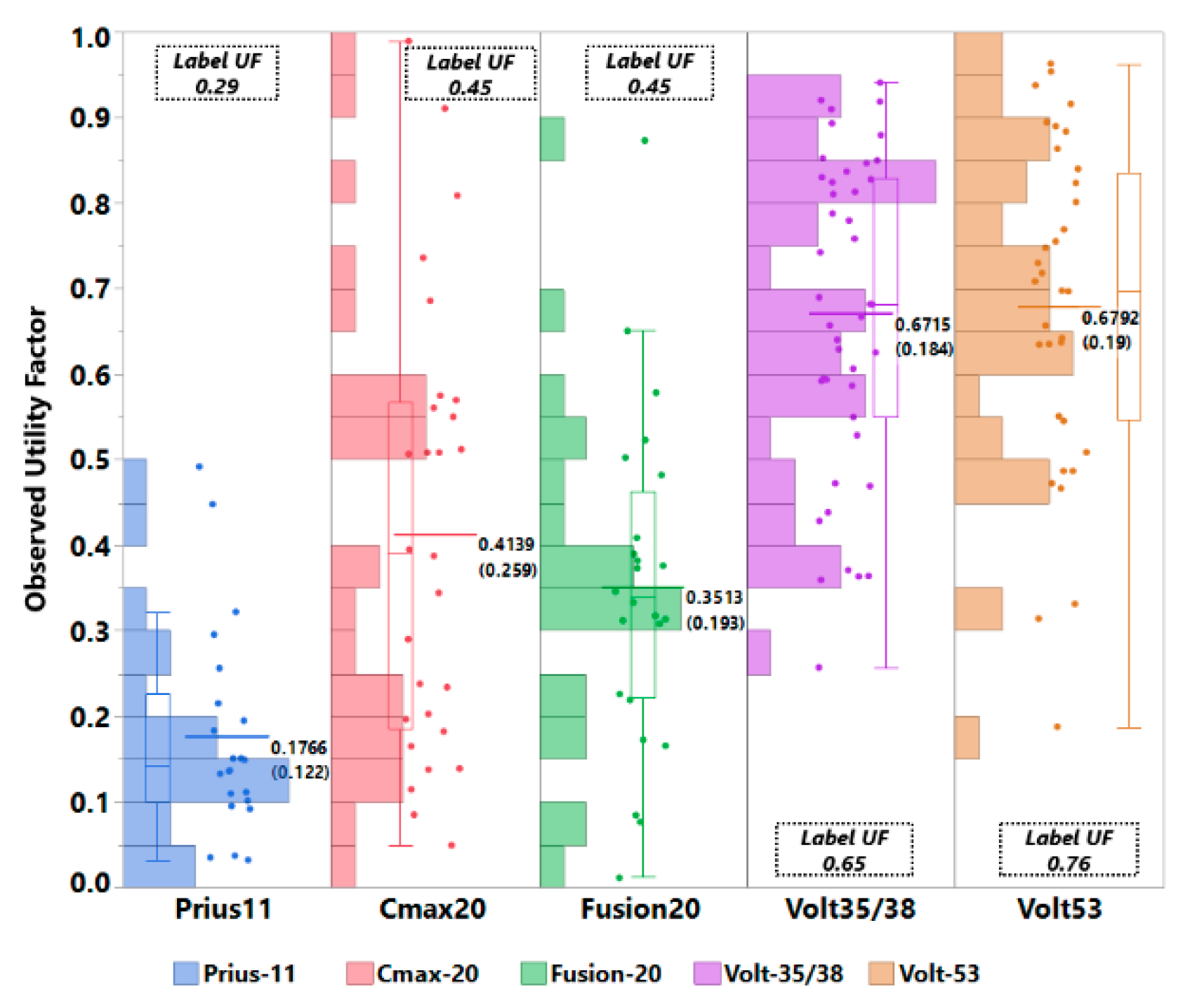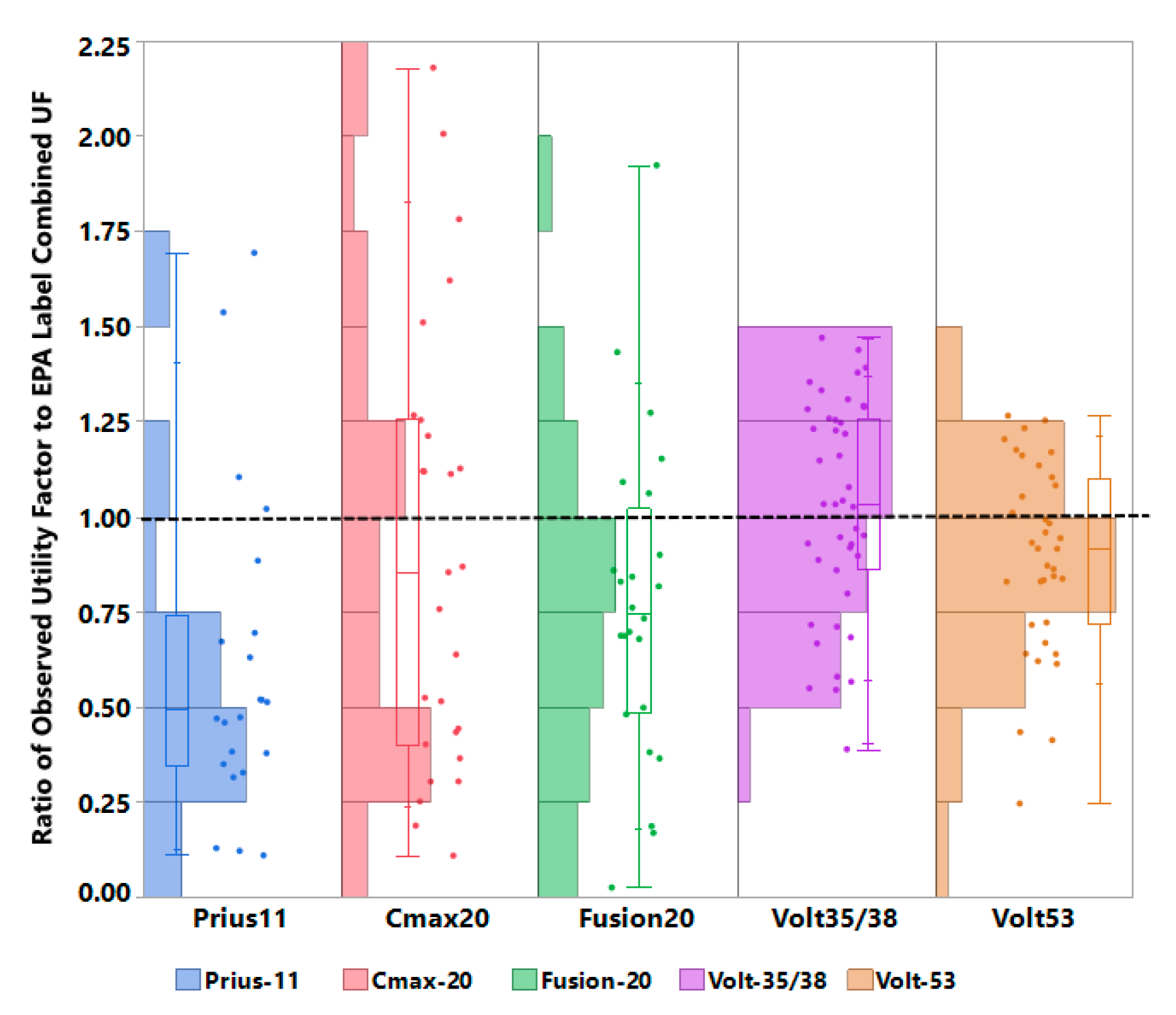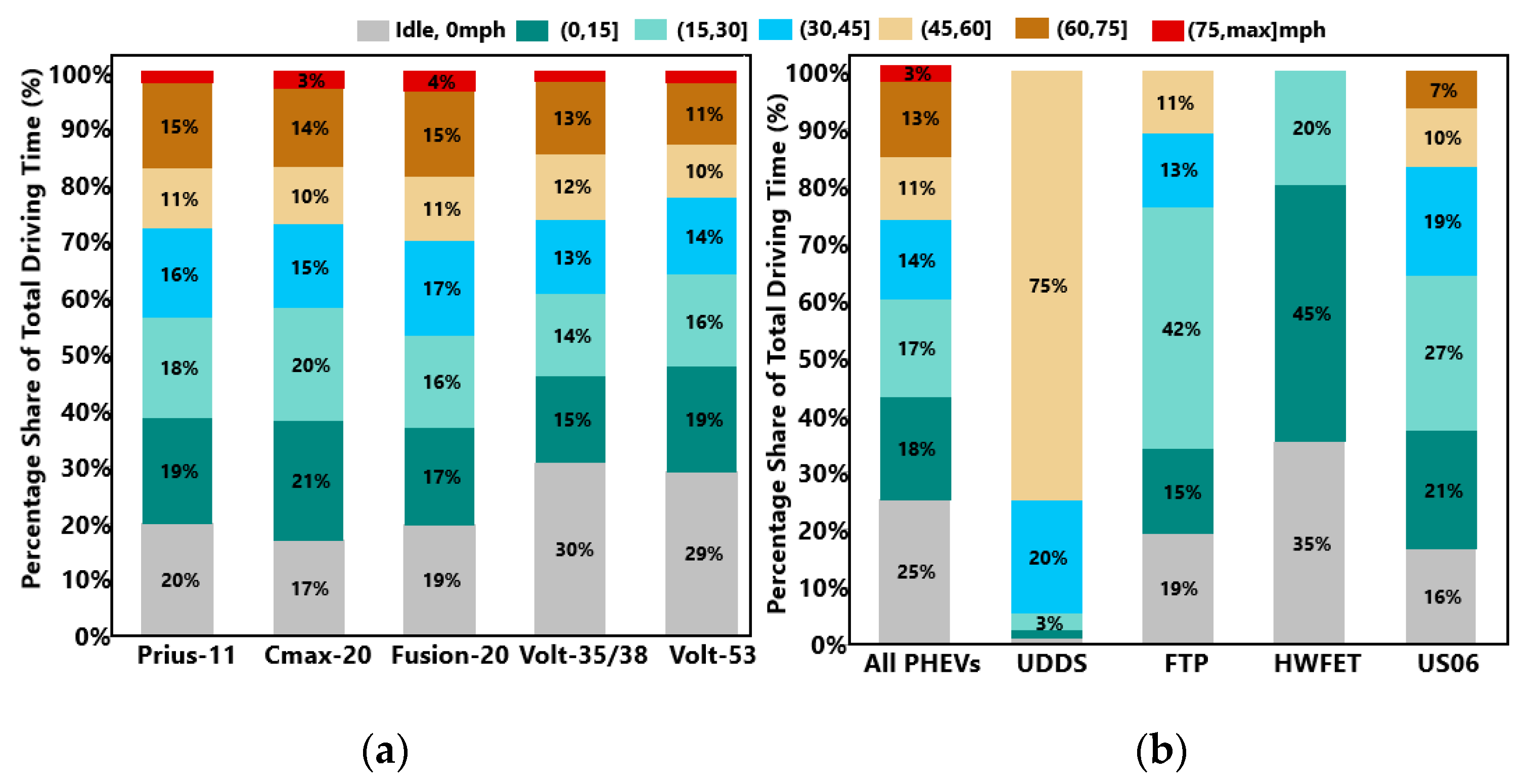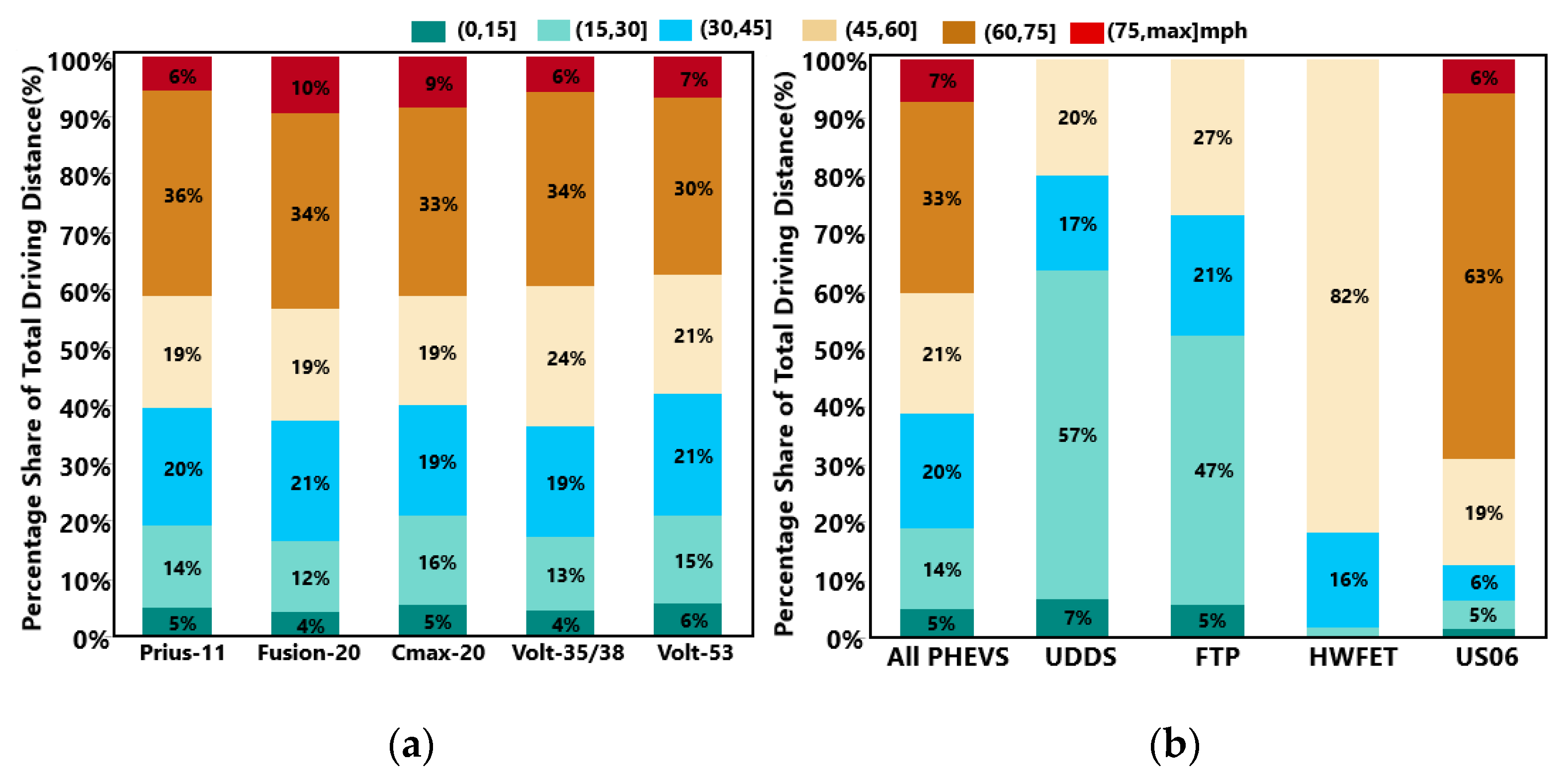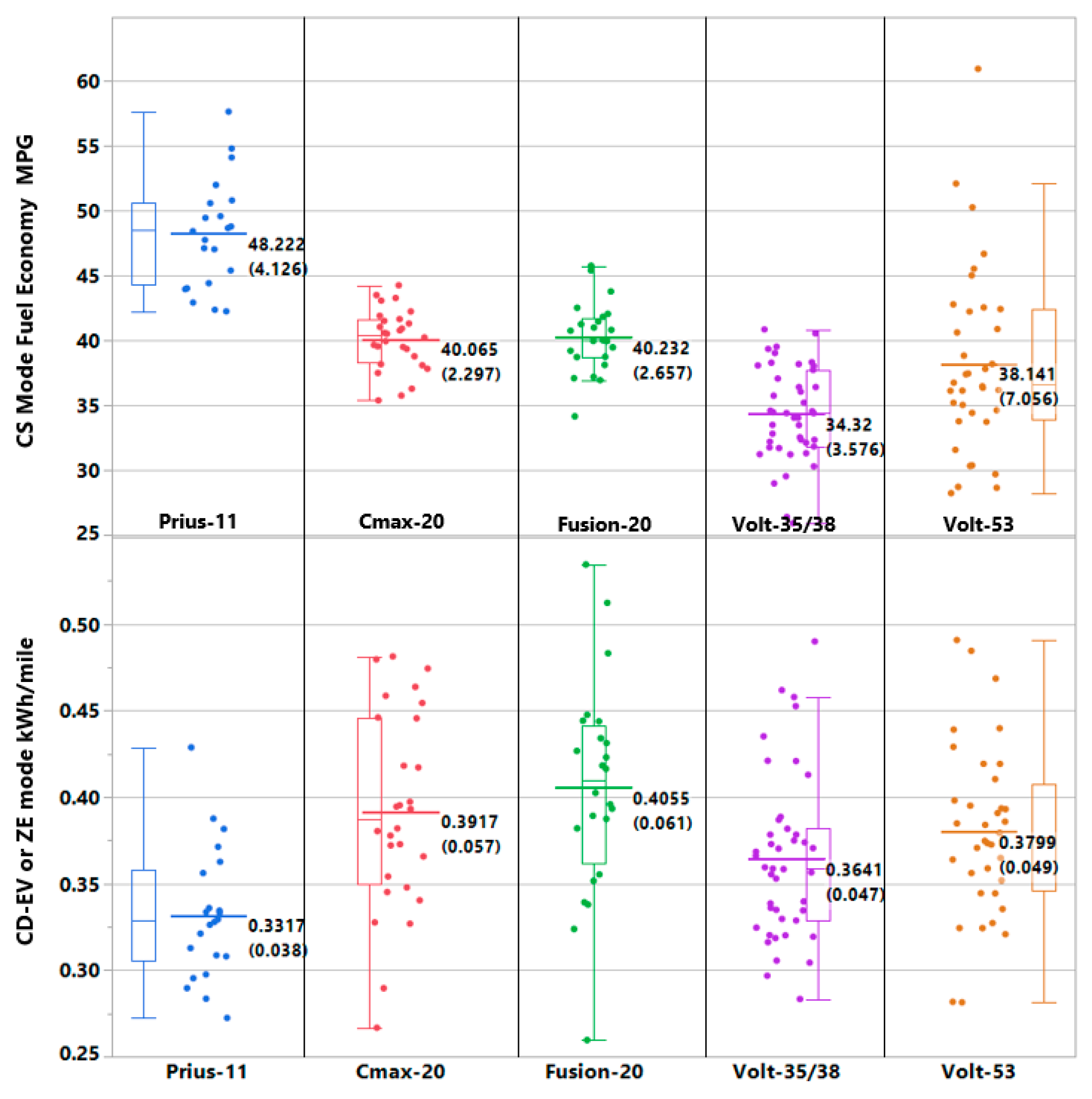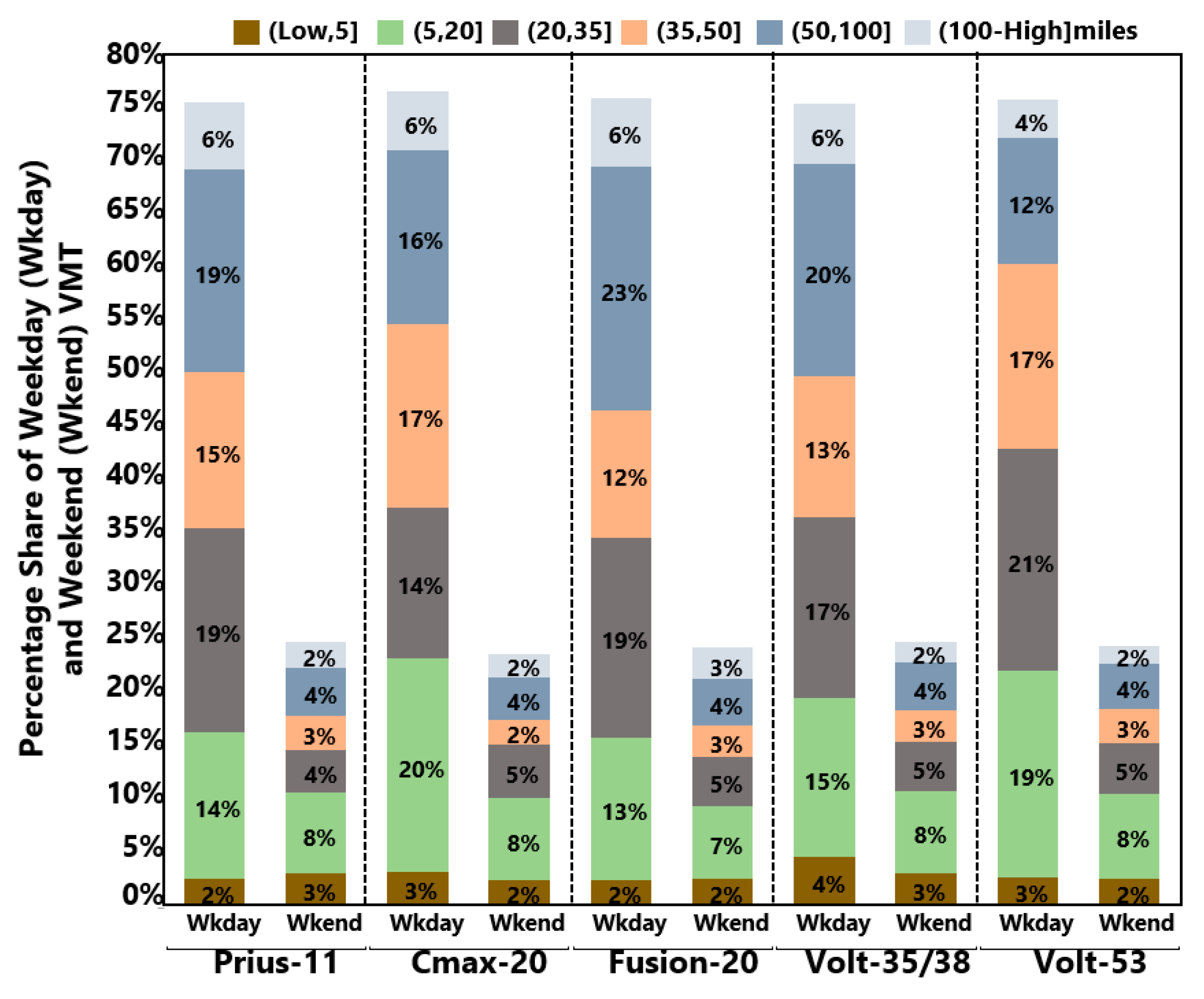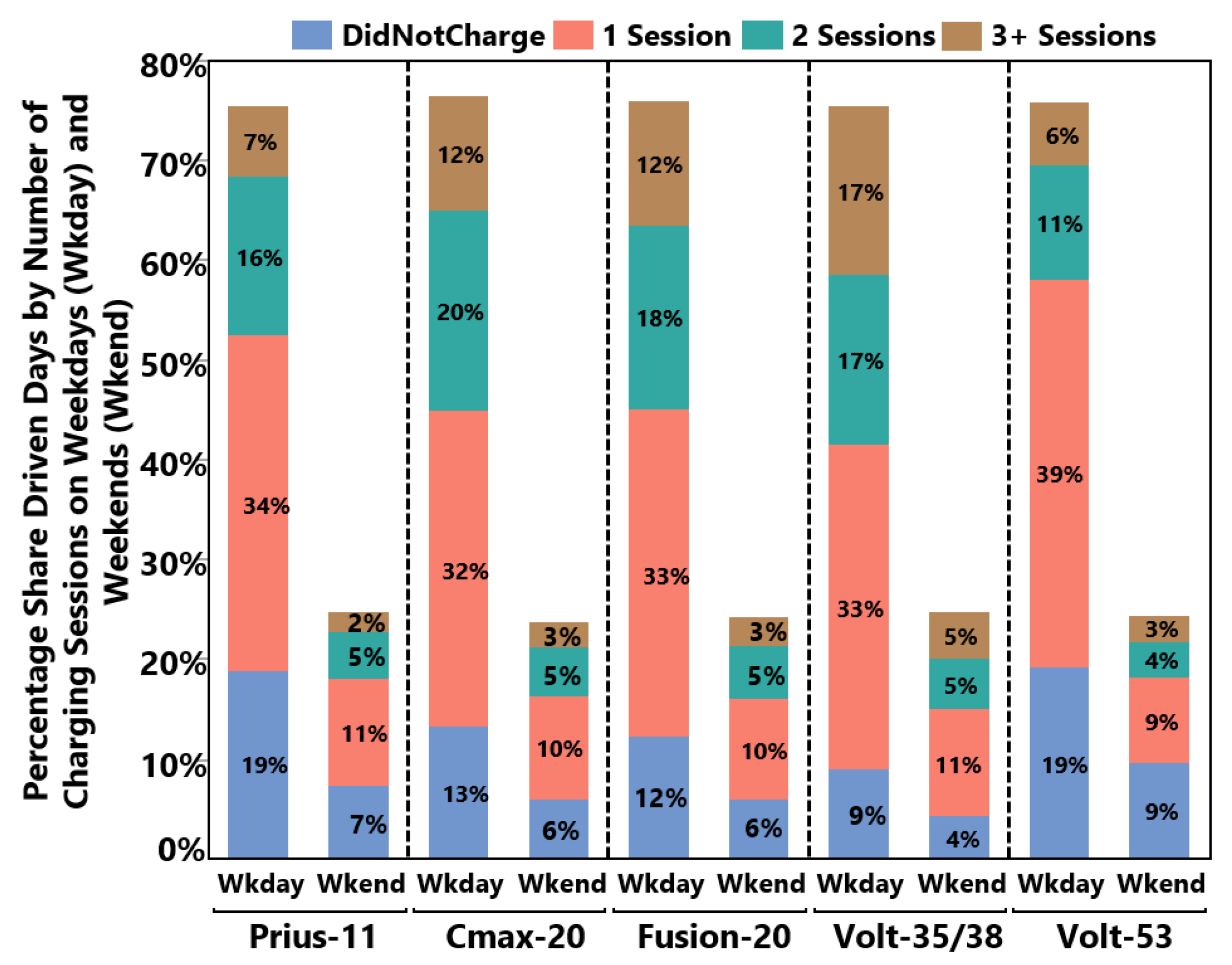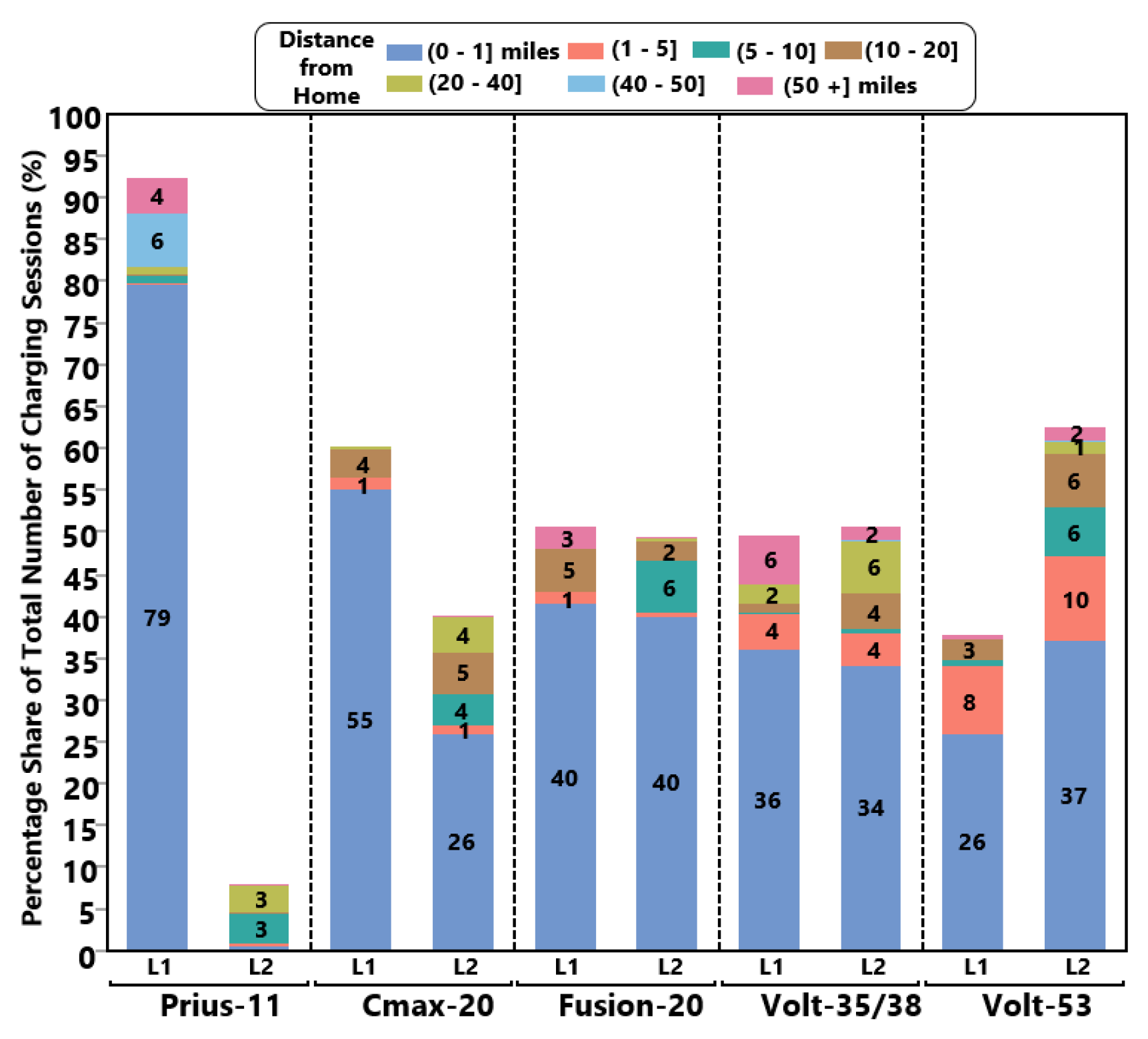1. Introduction
Climate change, air quality, and public health concerns have necessitated that governments across the world implement policies to promote battery electric (BEVs) and plug-in hybrid electric vehicles (PHEVs), collectively addressed as plug-in electric vehicles (PEVs). In the U.S., the transportation sector is responsible for 30% of total national greenhouse gas (GHG) emissions, and the light duty vehicle (LDV) segment alone contributed close to 60% of total transport GHGs in 2017 [
1]. In the state of California, 40% of total GHGs comes from the transportation sector, and the contribution from the LDV segment was close to 70% of transport GHGs [
2]. California and many other governments have implemented a suite of technology forcing mandates, performance standards for transportation fuels, GHG emissions, and incentive-based policies to increase the market penetration of PEVs [
3,
4,
5].
Plug-in hybrid electric vehicles are often considered to be a transitional technology with the potential to expedite the shift towards BEVs [
6,
7]. Plug-in hybrid electric vehicles are equipped with a larger battery pack compared to conventional hybrid vehicles (HEVs) that can be charged using grid electricity, and have an internal combustion engine (ICE). PHEVs are not limited by the range anxiety and higher upfront purchase cost concerns associated with BEVs, and they combine the pure electric driving capabilities of a BEV with the fuel and energy efficiency enhancements due to engine downsizing, low or no engine idling, and regenerative braking capabilities of an HEV. This design and operational flexibility allow them to be driven in Charge Depleting (CD) or Charge Sustaining (CS) mode depending on the source of motive power. Charge depleting (CD) mode can further be categorized into CD-EV and CD-blended (CDB) modes. In the CD-EV mode of operation, the entire motive power is provided by the electric motor by discharging the energy stored in the battery and the engine is never turned on. This type of operation is often called all-electric mode or zero emission (ZE) mode because only electricity is consumed and there are no tail-pipe emissions. Depending on the powertrain configuration, road network topology, speed and acceleration characteristics, and driver behavior, the engine may turn on to partially assist the motor in meeting the total propulsion energy demand in the CD mode. This is called CDB mode of operation because both electricity and gasoline are consumed, and the motive power is provided by the electric motor and the ICE. The CD mode of operation continues until the battery is depleted, after which the PHEV is operated in the CS mode as a regular HEV with the ICE providing the entire propulsion energy demand and only gasoline is consumed. Driving in the CD mode could be entirely electric VMT (eVMT) or a combination of electricity and gasoline (gVMT) VMT, whereas CS mode comprises of only gVMT.
A critical aspect while assessing the real-world environmental performance of PHEVs depends on the eVMT in the CD mode, which has direct implications on the fuel economy and exhaust emissions. In this regard, the concept of Utility Factor (UF) of PHEVs has been developed, which represents the proportion of VMT travelled on electricity. The formal procedures and test conditions under which the UF and the Environmental Protection Agency (EPA) “sticker label fuel economy” are estimated, are outlined in Society of Automotive Engineers (SAE) J1711 [
8] and SAE J2841 [
9] respectively. Standardized dynamometer certification cycles [
10,
11] are recommended in SAE J1711 to estimate the all-electric range (AER) and per-mile energy consumption in the CD-EV (kWh/mile) mode and miles per gallon (MPG) in the CS mode. Strictly speaking, AER or the charge depleting range, is the total miles traveled by a fully charged PHEV in the CD-EV mode prior to the first engine start event. To ensure parity and representativeness across geographies and socio-demographics with varying travel needs, the per mile energy consumption is weighted against national driving statistics such as the National Household Travel Survey (NHTS) [
12] in order to determine at an aggregate level how much of a vehicle’s driving can be accomplished on CD mode in SAE J2841. The SAE J2841 explicitly assumes that:
the PHEV starts its travel day on a fully charged battery;
PHEV is fully charged once per day on days driven at the end of travel day trip at home;
effect of additional intra-day charging and vehicle not being charged at the end of last trip nullify each other;
travel patterns and VMT by PHEVs are identical to the self-reported single-day trip diary information of mainstream ICE users in the 2001 NHTS.
Due to its simplistic and selective set of assumptions, the J2841 may not adequately reflect how PHEVs are driven and charged in real-world conditions. Using year-long longitudinal data collected via on-board data loggers from 153 PHEVs (11–53 miles AER) in California, this paper systematically examines the disparities between observed PHEV driving, charging behavior and generalized expectations about their usage patterns, and its implications on UF estimates encapsulated in existing PEV policies.
Prior studies that relied on cross-sectional travel survey data like the NHTS broadly focused on understanding the sensitivity of UF to different assumptions about travel patterns and charging behavior. In [
13] alternatives to the J2841 UF is proposed using the 2009 NHTS instead of the 2001 NHTS and a mid-day opportunistic charging, typically at the workplace, is also considered. Their study reported that the proposed UF is higher than the J2841 UF, but only for PHEVs with AER less than 65 miles. While the J2841 UF is strictly a distance based metric, Ref. [
14] proposes an energy based UF. Sensitivity of UF to different vehicle attributes such as age, class, annual VMT, and charging behavior depending on dwelling unit type is examined, and their analyses indicates that UF is largely insensitive to vehicle class and dwelling unit type, but highly sensitive to annual VMT, age, and charging behavior [
14]. With the availability of real-world driving data collected using loggers albeit from ICEs, efforts have been undertaken to develop a more realistic PHEV driving cycle compared to dynamometer cycles [
10] in order to better estimate their real-world energy consumption and emissions [
15]. The scope of such efforts expanded by incorporating additional charging opportunities based on dwelling times and location. High resolution GPS enabled travel data collected over a span of 18 months from 400 ICEs in the Seattle metropolitan area is utilized in [
16] to investigate how UF would change if only home based tours are considered. Their study reports that gasoline and electricity prices have no statistically significant impact on the UF, and that workplace or away from home charging increases the UF only if the AER of PHEV is less than 40 miles. Studies also applied UF by utilizing longitudinal data from ICEs for evaluating the life-cycle costs, emissions, and value proposition of PHEVs [
17,
18], and optimal battery size design and its impact on market acceptance [
19,
20].
Around early 2011, a nationwide PEV demonstration and charging infrastructure deployment was undertaken as part of the EV project [
21,
22] to understand Chevrolet Volt and Nissan Leaf usage patterns across 20 different U.S. metropolitan regions. This was the first project at such a scale that offered insights into the performance PHEVs by directly observing their actual usage via telematics loggers. In [
21] it is reported that the observed UF of approximately 800 Chevy Volts with 35 miles AER (2011–2012 model years) and 600 Chevy Volts (2013 model year) with 38 miles AER was higher than their respective SAE J2841 UF counterparts by at least 6%. Fewer share of long-distance travel days compared to the 2001 NHTS and charging more than once per day were attributed to be the reasons for deviating from J2841 UF estimates. A study of close to 60,000 Chevy Volts (2011–2014 model years) reported that the observed Volts were able to travel 74% of their total miles in CD-EV mode alone [
23]. Charging more than once per day by taking advantage of day time opportunities was identified to be the major reason for exceeding the J2841 UF and EPA sticker label fuel economy estimates similar to the findings of [
21,
22]. In [
24] a real-world fuel economy and UF of five PHEV models with 11–38 miles of AER is analyzed and their analysis indicates that deviation from certification cycle fuel economy were reported to be anywhere between 2% to 100% depending on the AER.
Most of the literature on PHEV usage focused on energy, emissions, and value proposition mainly from the perspective of driving. Reliable access to charging infrastructure is also important factor, because apart from user preferences, it is the availability of charging infrastructure that determines charger utilization and the charging demand. Understanding when, where, how long PHEVs are charged, and what the anticipated charging demand is are important factors for charging infrastructure developers from cost recovery, charger accessibility, user’s willingness to pay for charging, and charger utilization perspectives [
25]. Utility companies are particularly concerned about the additional demand imposed on the grid from charging, as it has the potential to create localized hot spots if not managed properly, necessitating network upgrade or expansion. This highlights the importance of deploying coordinated or smart charging strategies that incorporate not only the economics of charging but also user preferences for charging location, time of day, duration of charging, and charging power levels [
26]. Of particular concern are the competing objectives between the charging infrastructure developer and the user. The charging infrastructure developer seeks to minimize the cost of charging, which includes the fixed installation costs as well as the varying operating cost of providing electricity at the outlet. The PHEV driver, on the other hand, would like to maximize the convenience of charging without having to wait for a long duration, while simultaneously accomplishing this task at the lowest possible cost [
27].
In summary, apart from the J2841 assumptions, the nature of travel data (longitudinal or cross-sectional), duration of data-collection, mode of data acquisition (self-reported trip diaries, data loggers with or without GPS), type of vehicle(s) used for data collection, and the targeted population (mainstream ICE users, actual PHEV owners or potential PHEV buyers) will also have consequential impacts on the techno-economic, electrification, and environmental benefits of PHEVs. The significance of UF cannot be understated since it is the vital environmental performance metric on which many federal and state level policies such as Corporate Average Fuel Economy (CAFE) and Pavley GHG emission standards [
3,
28,
29], zero emission vehicle(ZEV) credit allocation under the ZEV mandate [
30,
31], vehicle emissions and label fuel economy estimates [
32,
33], and California’s Low Carbon Fuel Standards (LCFS) [
34] rely on.
The main contributions of this study are the following:
Comparative assessment of observed PHEV driving and charging and EPA sticker label expectations and the SAE J2841 assumptions.
Eight dominant factors (four each for driving and charging) that explains the variations in observed PHEV usage patterns are extracted using Principal Components Analysis (PCA).
Ordinary Least Squares (OLS) regression models are formulated to test the explanatory power of the factors by including them as dependent variables and the independent variable is the difference between observed and expected UF.
Relative importance of the extracted factors in terms of their contributions to the disparities between observed and expected UF is then quantified.
Though dimensionality reduction using PCA and regression modeling are commonly used, their specific application in the context of real-world observational study of PHEVs and UF is a new approach that is carried out in this study.
This paper advances to the body of literature that focuses on improving our understanding of the real-world UF of PHEVs by discerning influential driving and charging traits that contributes to the deviations from sticker label UF. To the best of our knowledge, compared to existing studies which limit their scope of analysis to either aggregate or daily levels [
16,
21,
22,
24,
35], this paper focuses on explaining why real-world performance deviates from label expectations by methodically examining disparities at varying time-scales (trip/charging sessions, daily, and annual); incorporates locational aspects of charging infrastructure access and utilization and how it impacts the UF; and explores if the key driving and charging factors that introduces deviations in real-world UF from their label values are the same irrespective of the AER. The outcomes of this study will offer a realistic assessment of the real-world electrification potential of PHEVs, challenges, and/or validates conventional wisdom on PHEV usage, and subsequently their energy consumption and emissions. Understanding the causes, magnitude, and direction of differences between assumptions about PHEV usage and their observed usage will help the broader scientific community in parametric updates, calibration, and validation efforts to strengthen the representativeness or correct for the lack thereof in vehicle choice modeling [
36], powertrain simulation tools [
37], integrated assessment studies [
38], charging infrastructure planning [
39], and emissions inventory [
40]. We expect the paper help in formulating policies aimed to incentivize PHEVs based on road performance and also to inform automakers when exploring future vehicle design.
The assemblage of data analyzed in this paper consists of driving and charging data collected between June 2015–June 2018 from 153 PHEVs in California. Five PHEV models are examined in this study: Toyota Prius (11-mile AER), Ford CMax and Fusion Energi (20-mile AER), Chevrolet Volts (35/38 miles and 53 miles AER). The rest of the paper is organized as follows.
Section 2 summarizes the aggregate driving and charging data and describes the quantitative methods used. Our analysis and results are detailed in
Section 3. Comparative assessment of observed driving and charging behavior with sticker label expectations, followed by the PCA and OLS model results are presented in
Section 3. We discuss our findings in
Section 4 and conclude this paper in
Section 5.
4. Discussion
This paper analyzed year-long driving and charging behavior of 153 PHEVs in California and compared it against EPA test cycles and SAE J2841 assumptions. We expanded upon these observations by examining usage pattern differences among the five PHEV models included in this paper. Our findings are summarized below.
Observed PHEVs are driven more aggressively and accomplish a higher share of travel in non-urban driving conditions (45 mph or faster or less than 3 stops per mile) compared to standardized dynamometer test cycles. The percentage share of time and distance traveled at highway speeds (60 mph or faster) is noticeably under-represented or excluded in test cycles. Approximately 80% of VMT in the UDDS cycle is at 45 mph or slower, whereas the overall average in our dataset was only 40%. Short-range PHEVs (Prius, CMax and Fusion) are driven 4% to 7% more at 60 mph or faster compared to longer-range PHEVs (Volts). The above disparities clearly manifested in the form of increased energy consumption in the CD-EV mode, which reduces the effective AER realized on-road. Using PCA, we characterized driving behavior based on 4 factors: vehicle usage intensity, aggressive driving style at highway speeds which increases the energy intensity, preference for long-distance travel, and conservative driving style.
Analysis of charging behavior revealed marked differences between the single, overnight, fully charged assumption of J2841. On average, observed PHEVs (except the Volt-53) charged more than once per day, and the driving distance on days when the PHEV was not charged was more compared to the days on which they charged at least once. Results indicated that short-range PHEVs have a higher share of driving days when they are not charged at all. The possibility of PHEVs to charge away from home, more than once per day, and PHEV being used like a regular HEV are the other notable distinctions between this study and the generalized J2841 assumptions. The differences in charging behavior outlined above are due to charger accessibility by location (home, away, or both), and charger utilization which could be defined based on frequency of charging or duration of charging. These were characterized using four influential factors extracted by the PCA. Regression models and relative importance analysis indicated that for short-range PHEVs (Prius, CMax, and Fusion), higher annual VMT and share of travel at highway speeds contributed the most to the observed UF being lower than label rated estimates, whereas enhanced charging infrastructure at home and while away increases the UF. In the case of the Volts, long-distance travel days (50 miles or more) and share of travel at highway speeds were the primary reason for lowering the observed UF below its label rated estimated, and increasing the frequency of charging at home increases the UF.
Driving related differences could due to a combination of road infrastructure, early adopter preferences, and vehicle technology attributes like age, AER, maximum electric speed, and drivetrain design. California has the third highest rural interstate and the highest urban interstate highway system length [
73], which was partly reflected in the relatively bigger share of highway speed driving observed in this study, compared to test cycles that are used in performance evaluation. California also scores low in proximity to major roadways [
74] and ranks among the top three states by average VMT in urban and suburban census tract groups [
75]. The cumulative effect of these California specific features were clearly revealed annual VMT and share of long-distance travel (50 miles or more) of the PHEVs observed in this study. The sub-sample of drivers in this dataset are PEV early adopters who purchased or leased a new PHEV and are generally more educated, wealthier, and own a home, compared to mainstream ICE user’s driving patterns in the NHTS on which the J2841 relies on [
76,
77]. Rebound effect in the classical sense by which improvements in fuel economy of newer vehicles increase the travel demand [
78], could also have played a part in higher vehicle usage intensity of all the PHEV models compared to sticker label annual mileage of 15,000 miles, except the Volt-53, which seemed to have faced a slight backfire effect [
79].
Apart from differences among the PHEV models in terms of annual VMT, driving style (aggressive or conservative), and the magnitude of long-distance travel, the distribution of UF (
Figure 1) indicates that heterogeneity in charging preferences exists among different as well as within the same PHEV model. The fact that some PHEVs, irrespective of AER, electrified less than 20% of their rated label UF demonstrates that motivations for charging or not charging are far more complex in reality compared to the simplistic notion of one fully charged session per day at home. Our study illustrates that charger accessibility and utilization have varying levels of influence on the UF depending on the AER. In the case of short-range (20 miles or less, Prius, CMax and Fusion), since their AER is less than their average daily VMT (about 46 miles), there was not enough incentive in the form of eVMT gained, to charge more for compensating their higher travel demand. Lower UF of observed PHEVs compared to their rated label estimates could also be due to self-selection bias by PHEV buyers who are less concerned about eVMT because their decision to purchase the PHEV was motivated by other reasons such as rebate, clean air vehicle decals, or preferential parking spaces. It is also evident that there are diminishing marginal returns in UF and eVMT with an increase in the AER, the case in point being the UF of Volt-53, which was similar to that of Volt-35/38, in spite of the Volt-35/38 driving 2000 miles more than Volt-53 annually.
The performance of PHEVs depends on the intertwined relationships between driving behavior, charging behavior, vehicle technology attributes, and user preferences. The dual propulsion energy source (electric motor and conventional ICE) enables the automakers to offer a wide range of design options to potential buyers depending on the degree of emphasis of one driving mode over the other, which is influenced by the policy goals. Fuel economy and energy efficiency of the ICE were prioritized over the all-electric mode operation due to cost and charging infrastructure considerations in the infant stages of the PHEV market. To maximize the GHG reduction potential of PHEVs, policies that encourage longer-range PHEVs which emphasize more on all-electric mode are needed. While this has a direct impact on the policy signals sent to the automakers and subsequently the model offerings available for potential PHEV buyers, it is critical to consider aspects outside the domain of vehicle technology such as charging infrastructure expansion and heterogeneous user preferences. Though this study does not advocate moving away or replacing the J2841 UF as the metric to quantify the environmental impact of PHEVs, there is definitely room for improving the accuracy UF estimates by incorporating additional scenarios that are more representative of real-world driving and charging behavior.
Generalizability and applicability of this paper’s insights to the broader PHEV market in general, or even within California, is not feasible due to sample size limitations, which is very common and unavoidable, and intrinsic to real-world observational studies. Moreover, today’s PHEV users are early adopters, whose socio-demographic and economic indicators differ from the general population of mainstream ICE users [
43]. In essence, results presented in this paper should be interpreted within developmental phases of the PHEV market.
5. Conclusions and Future Research Directions
This study systematically analyzed the driving and charging patterns of 153 PHEVs operating in California. The purpose of this study was to investigate why the observed performance of PHEVs deviated from their expectations and what the influential factors were that contributed to these disparities. We first compared observed and expected PHEV usage patterns.. We also compared the usage patterns of the five PHEV models (Prius, CMax/Fusion Energi, first and second generation Chevrolet Volts) that were analyzed in this study at time-scales varying from trip-level to annual estimates. We utilized principal components analysis to reduce the dimensionality of the dataset while capturing at least 87% of the variance in dataset using just four driving and four charging related factors. The explanatory power and the statistical significance of the extracted factors were evaluated using multivariate regression models. We quantified the relative contribution of each of the extracted factors toward the difference in observed Utility Factor from label expected values. We also investigated if there are any statistically significance interaction terms which further improve the regression model fit and offer additional insights.
Results indicated that higher annual mileage and higher energy intensity were the top two aspects that lowered the observed UF of short-range PHEVs (Prius, CMax/Fusion) when compared to label expectations. Enhanced charging infrastructure access and balanced utilization at home and away increased the observed UF of short-range PHEVs. In the case of longer-range PHEVs (Volts), their propensity toward more long-distance travel (50 or more miles/day), followed by their annual mileage, contributed the most to lowering their UF from label values. Due to their bigger battery capacity, increasing the frequency of shallow charging sessions had a bigger and positive effect on UF, rather than charging for a longer duration time, but less frequently. Regression models indicated that the effect of long-distance travel and deep cycle charging at home were statistically significant for longer-range PHEVs, but not for short-range PHEVs. Analyses also indicated the absence of any statically significant interaction terms. Distribution of UF (
Figure 1 and
Figure 2) indicated that even within PHEVs with the same AER, there was a diversity in usage patterns. Daily driving distances and style (
Figure 2,
Figure 3,
Figure 4 and
Figure 5), number of charging sessions on days driven (
Figure 8), and charging location distance from home (
Figure 10) demonstrated the linkage between travel and charging behavior and AER.
Plug-in electric vehicles (BEVs and PHEVs) are essential to reduce transport sector GHG emission and energy consumption. Plug-in hybrid electric vehicles are considered to be an intermediate and enabling technology option that can catalyze large-scale adoption of PEVs. The environmental benefits of BEVs are unambiguous due to their zero tail pipe emissions, however the same cannot be said of the PHEVs. Operational and fuel-use flexibility helps the PHEVs in overcoming range anxiety related issues associated with BEVs, but the same flexibility complicates the task of evaluating their net environmental impact. To address this, the concept of UF has been developed and widely utilized in the policy domain and techno-economic assessments. There is a growing body of demonstrable evidence suggesting that a mismatch or gap exists between official EPA sticker label and real-world UF, which warrants a deeper examination to improve our understanding of the electrification potential of PHEVs. This paper focused on this research need by scrutinizing real-world PHEV usage patterns and discerning salient facets of driving and charging that deviated from assumptions embodied in sticker label energy consumption and UF estimates.
Superimposing a set of preconceived notions about driving and charging behavior has direct ramifications on how PHEVs are evaluated in command and control policies like the ZEV mandate, regulations governing their on-road performance, and policies that encourage their usage through economic incentives. Developments in battery technologies, diversification of PHEV model offerings, expansion of charging infrastructure, and a favorable policy environment will increase the market share of PHEVs. As the PHEV market evolves and grows, the need for observing PHEV through studies such as the one presented in this paper will become increasingly valuable. Recognizing real-world scenarios that diverged from assumptions will better inform future policies.
The data collection is still ongoing and future work will include newer PHEV models such as the Chrysler Pacifica Hybrid (33-mile AER) and Toyota Prius Prime (25-mile AER). Future research will incorporate spatio-temporal aspects to identify trip level variables that affect decision to charge or not charge, identify missed charging opportunities at public charging locations, and its implications on the net environmental impact (driving and charging) and electrification potential of PHEVs.
